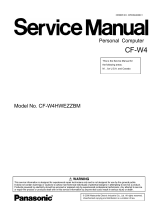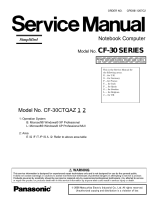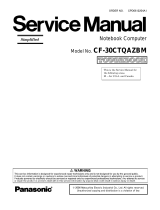
Read Me First
Models for U.S.A.
Federal Communications Commission Radio Frequency
Interference Statement
Note: This equipment has been tested and found to comply with
the limits for a Class B digital device, pursuant to Part 15 of the
FCC Rules. These limits are designed to provide reasonable
protection against harmful interference in a residential instal-
lation. This equipment generates, uses and can radiate radio
frequency energy and, if not installed and used in accordance
with the instructions, may cause harmful interference to radio
communications. However, there is no guarantee that interfer-
ence will not occur in a particular installation. If this equipment
does cause harmful interference to radio or television reception,
which can be determined by turning the equipment off and on,
the user is encouraged to try to correct the interference by one
or more of the following measures:
Reorient or relocate the receiving antenna.
Increase the separation between the equipment and receiver.
Connect the equipment into an outlet on a circuit different
from that to which the receiver is connected.
Consult the Panasonic Service Center or an experienced
radio/TV technician for help.
Warning
To assure continued compliance, use only shielded interface
cables when connecting to a computer or peripheral. Also, any
changes or modifi cations not expressly approved by the party
responsible for compliance could void the user’s authority to
operate this equipment.
This device complies with Part 15 of the FCC Rules. Operation
is subject to the following two conditions:
(1) This device may not cause harmful interference, and
(2) This device must accept any interference received, including
interference that may cause undesired operation.
FCC RF Exposure Warning:
This equipment is provided with PC Card slot that could be
used with wireless transmitters, which will be specifi cally
recommended when they become available.
Other third-party wireless transmitters have not been RF
exposure evaluated for use with this computer and may not
comply with FCC RF exposure requirements.
<Only for model with wireless LAN/wireless WAN/Bluetooth>
This equipment complies with FCC radiation exposure limits
set forth for an uncontrolled environment.
This equipment has been approved for portable operation,
and does not require any minimum spacing be provided
between antennas and all person’s body.
This equipment may not be co-located or operated with any
other antenna or transmitter.
25-M-3
<Only for model with wireless WAN>
This PC with WWAN transmitter installed, has been ap-
proved for mobile operation and to assure compliance with
RF exposure requirements, a minimum of 20 cm (8 inches)
must be maintained between the WWAN antenna located in
top of LCD and all person’s body (excluding extremities of
hands, wrist and feet) during wireless modes of operation.
<Optional Car Mounter / Port Replicator>
This equipment is provided with external antenna
connector(s) for connection to optional Car Mounter or Port
Replicator for mobile external mounted antenna(s).
External antenna(s) must be professionally installed and
cannot exceed recommended maximum antenna gain as
described in individual provided supplement instructions for
wireless transmitters.
For WLAN, the Car Mounter should be used with Radi-
all/Larsen WLAN whip antenna, type NMO5E2400BKTNC
with 5dBi antenna gain or less. Also, user must maintain
minimum 20 cm spacing between external antenna(s) and
all person’s body (excluding extremities of hands, wrist and
feet) during wireless modes of operation.
25-M-5
<Only for model with wireless LAN>
This product is restricted to indoor use due to its operation in
the 5.15 to 5.25 GHz frequency range.
FCC requires this product to be used indoors for the frequency
range 5.15 to 5.25 GHz to reduce the potential for harmful
interference to co-channel Mobile Satellite systems. High power
radars are allocated as primary users of the 5.25 to 5.35 GHz
and 5.65 to 5.85 GHz bands. These radar stations can cause
interference with and/or damage this product.
25-M-W-5
Responsible Party: Panasonic Corporation of North America
One Panasonic Way
Secaucus, NJ 07094
Tel No:1-800-LAPTOP5 (1-800-527-8675)
6-M-1
<Only for model with modem>
FCC Regulation Notice for modem
This equipment contains a FCC approved modem.
1. This equipment complies with CFR47 Part 68 rules.
On the computer is a label that contains, among other infor-
mation, the FCC registration number and ringer equivalence
number (REN) for this equipment. If required, this informa-
tion must be provided to the telephone company.
2. An FCC compliant telephone cord and modular plug is
provided with this equipment. This equipment is designed to
be connected to the telephone network or premises wiring
using a compatible modular jack which is Part 68 compliant.
See Installation Instructions for details.
3.
The REN is used to determine the quantity of devices which
may be connected to the telephone line. Excessive RENs on
the telephone line may result in the devices not ringing in re-
sponse to an incoming call. In most, but not all area, the sum of
RENs should not exceed fi ve (5.0). To be certain of the number
of devices that may be connected to a line, as determined by
the total RENs, contact the local telephone company.
4.
If your telephone equipment cause harm to the telephone network,
the telephone company will notify you in advice that temporary
discontinuance of service may be required. But if advice notice
isn’t practical, the telephone company will notify the customer as
soon as possible. Also, you will be advised of your right to fi le a
complaint with the FCC if you believe it is necessary.
5.
The telephone company may take changes in its facilities, equip-
ment, operations or procedures that could affect the operation
of the equipment. If this happens the telephone company will
provide advance notice in order for you to make necessary modi-
fi cations to maintain uninterrupted service.
6.
If trouble is experienced with this equipment, for repair or
warranty information, please contact Panasonic Corpora-
tion of North America at DIAL TOLL FREE 1-800-LAPTOP5
(1-800-527-8675). If the equipment is causing harm to the
telephone network, the telephone company may request that
you disconnect the equipment until the problem is resolved.
7.
There are no user serviceable parts contained in this equipment.
8.
This equipment may not be used on coin service provided by the tele-
phone company. Connection to party lines is subject to state tariffs.
9. The Telephone Consumer Protection Act of 1991 makes it unlawful
for any person to use a computer or other electronic device to send
any message via a telephone fax machine unless such message
clearly contains in a margin at the top or bottom of each transmit-
ted page or on the fi rst page of the transmission, the date and time
it is sent and an identifi cation of the business or other entry, or
other individual sending the message and the telephone number of
the sending machine or such business, other entity, or individual. In
order to program this information into your fax software, you should
refer to the manual of the Fax software being used.






















